I have definite ideas about how to catch big trout. Apparently they are all wrong.
Like every other guy or gal with a fly rod, I have some pretty strong opinions about the kind of flies that catch big fish. These opinions are based on years of experience and experimentation. I have theories about the behavior of big predatory trout and they influence my tying and my fishing. These ideas are proven out by countless hours on the water. At least that’s what I thought.
Regular G&G readers will know that I am a confirmed streamer junkie. I make no apologies for it. I love fishing streamers and I believe wholeheartedly that big flies catch big fish. Here’s the problem: without knowing it, for the last eight or ten years I’ve been proving myself wrong.
I am not a fish counter. I’m not a trophy hunter. I like catching big fish but I do not possess a single mount or even a catch-and-release painting. Not surprisingly, I don’t even have a lot of photos of myself with fish. Most of the fish I catch, if they are photographed, are in someone else’s hands. The truth is that I am just fundamentally more interested in the next fish than I am the last fish.
What I do, on very rare occasions, is keep a fly. Once in a while I’ll catch a fish that’s special. It’s always a big fish but there’s usually something extra that makes it special. The color or fins, or maybe where I caught it or who I was with. It happened the other day in Alaska. I was fishing with my good buddy Bruce Chard and guide Jeff Forsee on the Kanektok river at Alaska West. On literally the last cast of the day I hooked and landed a rainbow in the ten- to twelve-pound range. A beautiful and perfect Alaska rainbow.
It was a great fish by any standard but particularly special because I caught it with Bruce. There is no one in the world I enjoy fishing with more than Bruce and we have fished together more days than I can remember, but all in the salt. This was the the first and only day we have trout fished together. It is also the first and, very likely, the only day I will ever catch the fish of the day with Bruce on the boat.
We are not competitive with each other in any way, but it was a moment that did not pass without notice, so I clipped off the fly and stuck it in my camera case. When I got home I took the flesh fly, that Jeff had tied, out of the case and tossed it on the mantle next to a fly I used to catch a forty-two inch steelhead last year on the Dean River in BC.
I looked at the two flies and it made me think. I scrounged around for a couple of other flies I had kept. This habit is so trivial that I don’t even keep them in the same place. One has been in the headliner of my car for at least five years. Looking at this handful of flies I realized that a lot of what I thought I knew was wrong.
I’m going to be very honest with you. I don’t know what I think about this. I still have great faith in the streamer patterns I’ve developed over the years and they produce a lot of quality fish for me on a consistent basis but there was not a one of them in this collection. Not one! In fact the four flies in my hand totally surprised me. Without exception they were small, natural and traditional. I realize that this is in no way a scientific sampling or or even a thoughtful conclusion. It’s more of a forensic discovery. Rationally I’m struggling with it, but I can’t argue with the proof in my hand.
So rather than draw a conclusion or cook up a theory, I’m just going to share with you the facts. Over the last, I’m not exactly sure how many years, I have chosen to keep these four flies, with which I caught these four fish. You tell me what it means.
Fish #1 Alaska Rainbow around 10 lbs
Caught on a fairly simple marabou flesh fly tied by my guide Jeff Forsee
Fish #2 male rainbow 27 inches
Caught on a #14 Hairs Ear Soft Hackle tied by me
Fish #3 Dean River Steelhead 42 inches
Caught on a black Marabou Tube Fly tied by Justin Berry
Fish #4 exceptional male brown trout 26 inches
Caught on (of all things) an olive Woolly Bugger size 10 tied by me
So there you have it. Four nice fish caught on four modest flies, none of them containing more than three materials, none of them taking more than a few minutes to tie. For all of our innovation and creation it seems that natural traditional flies are definitely holding their own.
Leave a comment and let me know what you make of this.
Louis Cahill Gink & Gasoline www.ginkandgasoline.com hookups@ginkandgasoline.com Sign Up For Our Weekly Newsletter!
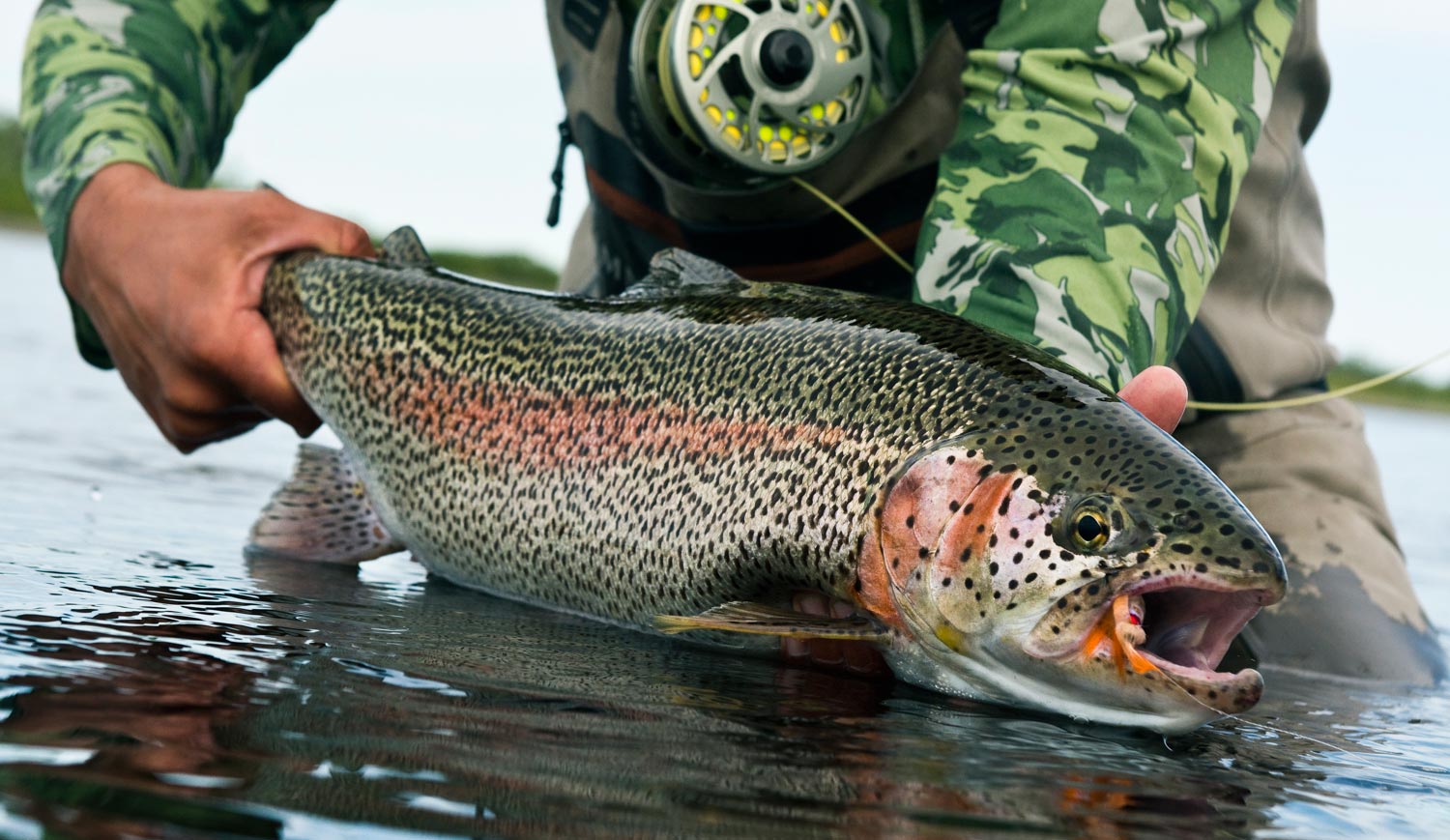
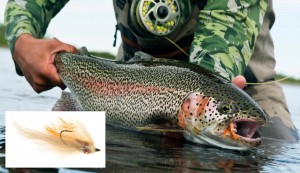
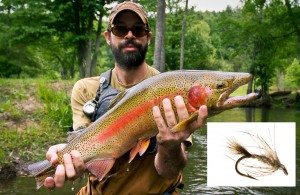
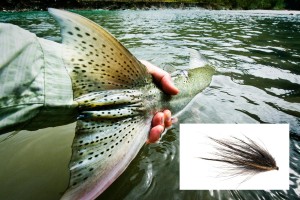
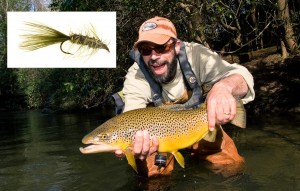
for some reason the hare’s ear and woolly bugger are no surprise. I only wonder why we don’t reach for them with more consistency. Mentioned to a client yesterday when last year client A. in front of boat, experienced and determined, while brother-in law in stern, simply trolling a black bead head woolly bugger catches an 18″ brown in the middle of the afternoon…
you never know.
Tight Lines,
Koz
I feel the same way as you, also a streamer guy. My biggest fish ever was a 48″ atlantic salmon on a size 10 olive wooly bugger.
i’m not in the least surprised Louis.
my two biggest trout, a brown and rainbow, both of 76cm/30″ where both caught on a micro clouser-inspired variant made of marabou no longer than 1″ in length.
sure, i almost always have real big stuff in the chestpack somewhere but it usually gets used as a last-resort. they work but it seems like (at least in the waters i fish in Europe) takes on big Galloup-style trout streamers mostly get bites out of an aggressive territorial response from the bigger fish than one of ‘normal’ feeding.
cool that you keep special-moment flies, i do the same but at least they’re in a box… 😀
great fish and read as usual !
cheers,
marc
A few thoughts…..
I firmly believe that one of the biggest factors in catching fish is confidence. There are presentations I like under certain specific circumstances that I have a lot of confidence in. However other people doing different things do as well or better, strongly suggesting it isn’t a magic fly or a different sink tip that leads to success. If you believe in what you’re doing, you fish better. I have no idea how you would measure that or prove it one way or the other. But I’ve seen it happen for 50 years.
You said you’re not specifically looking for “trophy” fish, however you do seem to be able to pick your spots. The chances of you running across a 12 pound Rainbow are probably a lot better on the Kanektok than they are on the Kinnickinnic. However if you only fished the Kinni and were after large specimens, maybe your streamers would be a better option after all.
And finally I have long thought that big specimens aren’t necessarily smarter, and they aren’t shy or they wouldn’t have eaten enough to grow that big in the first place. I do think they’re suspicious. Unnatural colors and synthetic flash might excite a lot of fish, but the big boys just might slink back up under the cut bank and watch that go by. Dull, drab colors might not arouse those suspicions and get eaten.
Or I could be completely wrong about all of this!
Interesting article.
Interesting post. All the big ones came on natural materials in subtle colors.
Perhaps the banded rubber legs, sparkle materials and bright colors catch the fly fisherman but rabbit, marabou and chicken catch the fish?
Many articles talk about the sparkle spooking big fish. Most those big bonefish hero shots have a very dull looking rabbit or marabou fly hanging from the lips. The fish lips that is.
Over the past several years, some of the largest Trout (Browns & Rainbows) I have ever caught, on a certain Eastern Sierra tailwater, have taken a #18–#20 Cream Miracle Midge…conventional wisdom calls for larger streamer patterns in the #2-#8 category…go figure…
PT/Tim Barker
I definitely get your point about big fish on flies that you wouldn’t expect to be the winners… My biggest brown thus far was 27″ and 11 lbs on an egg bead… However it was during the time of year that really warrants eggs in the water and that’s why it was on my line.
I still believe that something like a streamer or other big stuff is the most CONSISTENT way to catch big fish. This doesn’t necessarily mean you WILL catch the biggest fish on one of those flies. It just increases the chances that those fish coming in to eat your fly (streamer) will most likely be a bit larger than if you were fishing normal bugs and matching the hatch.
Perhaps you tend to keep flies that have performed beyond your expectations? This would naturally lead to saving little flies that Catch big fish since the large ones are simply expected to do so.
The Yellow Woolybooger “has caught more fish than you have ever lied about” ( quote from which fishing movie?). Yellow Woolyboogers s hould be in your box as well.. I have caught large trout with it.. It works as a bass fly.. Guess what even works for stiped bass and blue fish! You would also be surprised what tying a droper fly from your olive or black Woolybooger will do.. A size 18 or 20 flashback pheasant tail or any kind of midge will yield a nice fish.. Thanks for the discussion!
Maybe it is not a bad idea to tie on a small fly behind the big one. The big one can be seen for a long way and get the fish close enough to see the small fly which looks like food. Since the fish has gone to the trouble of swimming over to check out the big fly it might eat the small one since it is available. Sometimes a fish will not go too far to eat something small and unidentifiable.
If you have ever seen the contents of trout’s stomach it is amazing what they will ingest sometimes, including inanimate objects like cigarette butts, cigar butts, twigs, leaves, seeds and seed pods, and all manner of vegetation and other foreign objects. They are opportunistic feeders, especially in current flows. And when something gets into their field of view, they just may grab it. What i like about this essay is that it is a reminder that we can keep it simple, and focus on presentation.
With the exception of the egg hatch season almost all my large lake-run fish have been caught on smaller neutral colored flies especially lightly weighted size 10 Olive Wooly Buggers and Olive or Brown Rabbit Leeches. On pressured waters I go even smaller with loop knots and focus on my dead-drifts. Both patterns excel in that they have natural movement on the dead-drift and the swing. Over time I have reduced the patterns that I tie and fish. Hares Ear nymphs, Pheasant Tail nymphs, Wooly Buggers, Soft Hackle Streamers, Clousers, Rabbit Strip Leeches and San Juan Worms in different sizes and colors. Along with Parachute Adams, Foam Crickets/Beetles, Ants and Soft Hackle Wets. Someone mentioned confidence in the fly, I agree that is critical. Understanding how to fish each fly under different conditions is key to the right presentation.
That reminds me. Time to buy a new hare’s mask and get tying. But seriously, most of the guys I know downunder usually sight fish small flies in rivers as their first preference and go for bigger streamers and buggers when the small ones aren’t working or when they want to change things up. Interesting blog
This doesn’t surprise me in regard to trout. I have caught more quality fish using a sawyer killer bug than any other pattern. Doesn’t get any simpler than this pattern. Congrats on the great Alaskan bow!
Pingback: Tippets: Restoring the Greenback, Big Fish and Small Flies, Logging in the Tongass | MidCurrent
Hey Louis, this article is only telling one side of the story. What about all the big fish you’ve caught on big streamers? Where are they? Where are those big flies? Before drawing any conclusions you’d need to look into how many big fish you’ve taken on streamers and compare the numbers to the big fish taken on small flies. Maybe you have photographic proof that will help. Until then there’s no way of knowing if the split is 50/50, or something more extreme like 80/20. I know you said this is more of a forensic discovery, but it’s still bothering you and you can’t argue with the “proof.” Don’t let it bother you. You’ve only kept 4 flies of all the big fish you’ve caught. That’s hardly proof. It’s a tiny sample. Sure, they caught fish, but I’d like to see the big streamers that caught big fish and compare the numbers before letting this eat you up.
Its funny you mention this – I was thinking the same thing last night. A majority of my fishing is done in northern Maine for brook trout and salmon, and I’ll harp all day about my love for big streamers. We’ll catch big fish on streamers all day, but most of those patterns are classics. Grey Ghosts, in the past Mickey Fins, etc etc. However, some of the best fish I saw between my buddy and I last year came on smaller flies – i.e. bitch creeks, maple syrups, small conehead buggers. My two salmon in the winter months were on size 2, 6x long shank weighted wooly buggers. Theres just no rhyme or reason to it, but I will vouch for our Maine fish preferring the more natural colors. I’ve never done particularly well on flashy variations full of synthetics.
I believe paying attention to whats in the waters is critical, but more importantly is what makes the angler tick when choosing flies. In other words fly confidence. I’ve taken this lesson to heart and when teaching or guiding I select out a handful of likely flies (as needed) that will do the job, but I always let the client ultimately choose what fly speaks to them. Even if its the absolute wrong fly (judged by others) and not one of the preselected. The only wrong choice for me is no fly at all. I got schooled big time early on when I first started to teach newbies who would pick a fly I thought would never work, yet it would be a lucky charm for that individual. After that lesson I gained immense respect for anyone’s gut opinion and try to cultivate it individually. The angler that listing to their gut and chooses a fly that speaks to them in my humble opinion will always fish it better – small, medium or large. I believe this is where we enter flies into the art realm of individual interpretation.
I kept the same for the fish too. but I could not understand what it is
That’s funny stuff. I do the same.
I have a few flies in one of those old type-setter drawers used as a shadow box.
So, where ever I fish (on a trip like a spring creek out west or a trip to a limestoner in PA) I collect a rock that is representative of the stream. I then glue a fly that I caught a fish on to the rock and label it with the stream and date. The only pic I have is of a BIG snook I caught and put the pic in a shadow box with the fly (a clouser) and a small conch shell. They are on a shelf on my desk. Fun looking back and remembering the days over the years.
Marabou, hackle, hare’sear. What do all these have in common? Motion! Parts of the fly move! Like a real living thing. It doesn’t have to be natural material. Use some of the dubbings from Fly Tiers Dungeon, especially for small streamers or leeches. Other than minnows, what is the largest prey that most bass or trout will see? Leeches.
I am following up on some advice I got when I started fishing tailwater streams. If you are not catching fish, go smaller with your fly. Last September on a five day trip, I landed 10 fish, about two a day, all with a size 22 zebra midge. The smallest was 19″, the largest was 27″. Still can not wipe the smile off my face.